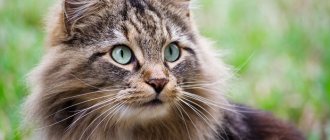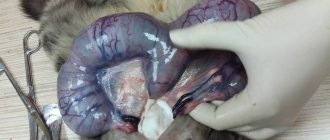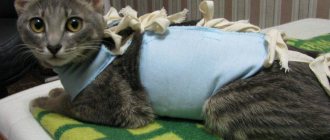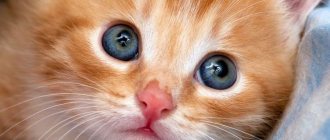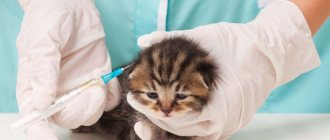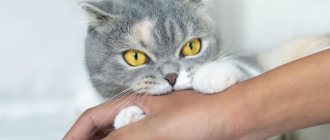Factors influencing puberty
Males and cats reach sexual maturity at different ages. Puberty in males occurs later than in male cats, which matures along with the first estrus, which begins at 5-6 months. But the timing of puberty may vary. This depends on certain factors:
- Belonging to the breed. Representatives of oriental breeds: Siamese, Thais, Orientals, Burmese and St. Petersburg Sphynxes belong to the category of early maturity.
- Skeletal structure. Cats and cats of graceful build with thin bones enter puberty earlier than their powerful counterparts.
- Seasons. Kittens born in winter or spring enter sexual maturity in spring or summer, while later litters have delayed sexual maturity.
- Conditions of detention. Compliance with the regimen and quality of feeding, as well as comfort and convenience, accelerates the maturation of the pet.
- Features of the habitat. Surrounded by adults (in a nursery or pride), young felines mature earlier than their peers from city apartments.
- Genetic predisposition.
If the pet is overfed and overweight, puberty in cats is delayed and can occur by one and a half or two years.
How to determine the age of a cat
Tough
Teeth are an indicator of age (this method works best to determine the age of a kitten). Veterinarians most often use them to determine the age of the animal.
- If you find only the first baby incisors in the kitten’s mouth, then he is from 2 to 4 weeks old.
- If milk fangs are found next to the incisors, then you have a kitten 3-4 weeks old.
- The presence of premolars indicates an age of 4-6 weeks.
- If baby teeth are replaced by permanent ones, but the molars have not yet erupted, the kitten is 3 to 4 months old.
- White, healthy permanent teeth indicate an age of 6 months to a year. There should be no tartar or signs of wear on them.
- Slight yellowing of the enamel and worn middle incisors of the lower jaw indicate an age of 2 years.
- The presence of tartar on all teeth and abrasion of the central incisors of the upper jaw - 3-5 years.
- If the pigmentation of the enamel is disturbed, and the outer incisors of the upper jaw are erased, you have an animal of 6-7 years old.
- Severe yellowing and wear of all teeth, as well as the absence of some teeth, are over 10 years of age.
- Falling out fangs indicate advanced age - 15-18 years.
It should be noted that teeth are not an absolutely accurate indicator of the age of an animal. They may be in poor condition due to improper care of the animal, or, on the contrary, snow-white teeth may mislead you when calculating the age and only indicate impeccable care for the animal.
By sexual maturity
If your cat is trying to mark its territory, the urine has a specific strong odor - this indicates that the pet has reached sexual maturity (usually this occurs at the age of about 5-6 months).
Mature cats become very affectionate and emit loud meows. They go into estrus, calling for potential suitors, starting at 5 – 12 months of age.
By type of wool
Younger cats have soft, fine fur. With age, the coat becomes coarser, the color may lighten or, on the contrary, darken. Older animals, like people, experience gray hair. These can be individual white or gray hairs, as well as entire spots.
By the eyes
Juveniles usually have clean, clear and bright eyes. With age, you may notice a change in eye color or the presence of clouding, pigmentation disorders of the iris. If a cat is over 6 years old, its eye lenses become denser. This can be seen using an ophthalmoscope.
After reaching the age of 10, clouding of the iris is visible to the naked eye.
By body type
Age-related changes affect the entire body. Based on the state of the pet’s body, the following conclusions can be drawn:
- young animals are usually more muscular and lean due to their higher activity level;
- middle-aged cats are more well-fed and rounded, but at the same time the muscular corset is well felt;
- In older animals, the bones of the shoulder girdle protrude greatly, and they have flabby and wrinkled skin.
By behavior
The level of activity and daily routine (alternating sleep and wakefulness) can also tell owners the approximate age of the pet. You need to carefully watch your cat and kitty.
Behavioral signs indicating the age of a cat:
- Young animals are usually more playful and inquisitive. They alternate periods of daytime sleep with long periods of wakefulness.
- Middle-aged animals have not yet lost interest in the world around them, but behave more restrained and cautious.
- Older cats are less active and spend most of their time sleeping. They often confuse day with night.
- Fear, anxiety and aggressive behavior are most common in older animals.
Video how long do cats live:
Manifestations of puberty
Behavior at the onset of puberty varies between male and female cats. In females, this period is accompanied by discharge from the genitals - estrus. External signs of approaching heat are manifested in an increased desire to caress, rub against legs and furniture, and when it comes, the cat’s behavior becomes more defiant: it begins to meow invitingly, rolls on the floor, moves its tail to the side, demonstrating sexual desire.
Puberty in cats is accompanied by more aggressive behavior. The mustachioed one begins to meow loudly, attracting females, marking territory, and its urine during this period has a sharp, unpleasant odor. The cat’s character also changes - he can tear off furniture and walls, show increased playfulness, and his games are similar to scenes of hunting prey.
With the onset of puberty of the animal, the owner must decide whether he wants offspring or not. If the owner is focused on breeding cats, then he needs to find out whether the pet has breeding value and select a candidate for mating. All events can be held in clubs for cat lovers or take advice from a trusted nursery or an experienced breeder. It should also be understood that puberty and physiological maturity of a pet differ in timing: the latter occurs closer to one year of age.
If no one is going to breed a female cat, then castration or sterilization will be the right decision. This will be more humane to the animal and safer than drug regulation of sexual heat.
Stages of growing up
Growth limits for each animal are individual, but there are averages. It is known that the phase of most active development ends at the age of 10-15 months. Large breeds such as Britons continue to grow for some time after puberty. Small and medium breeds finish their development earlier. These include, for example, fold-eared and straight-eared Scots (medium breeds), and among small ones - munchkins.
There are several main stages of kitten development (starting from birth). In order for the baby to develop correctly and be in good health, it is important that favorable conditions are created for him at each stage:
- The neonatal period (lasts 4-7 days after birth) is a phase of continuous growth, although it is possible that the kitten will lose some weight during this period.
- The suckling period (lasts 3-3.5 weeks). Rapid weight gain phase. Kittens are rapidly increasing in size and learning to navigate independently.
- Transitional period (lasts from 4 weeks to 2 months). The first teeth appear. At this age, complementary feeding and transition to independent feeding are carried out. There is a significant leap in development.
- Adolescence (lasts until the end of active development). Phase of active and uniform growth. This is the period of formation of the skeletal and endocrine systems. It is important that the diet at this time is of high quality and complete.
Active formation of the bone apparatus lasts up to six months. For proper bone growth, the kitten must receive sufficient amounts of calcium and vitamin D during this period.
Cats stop growing by the age of 3, and cats already look like adult animals at 2 years of age. At this time, their ovaries activate. After the bone skeleton and muscle corset have completed their formation, an increase in body weight and size occurs only due to the accumulation of fat.
The best time for mating
Everyone has heard how the March cats begin to sing with the beginning of spring, but not everyone thinks about why this happens. But the fact is that March is the best time for conceiving future offspring and it is at this time that sex hormones begin to rage, because the whole summer and autumn are ahead for successful feeding of babies: the weather is warm, you don’t need to go far for food and leave the cubs unattended for a long time. Although in city conditions, March cats can continue to sing both in summer and autumn, because the basements are warm and cozy, and there is enough food in the garbage chutes to survive.
The intensity and volume of cats' screams during the mating period directly depends on the number of rivals in a given territory. The more competitors, the more heart-rendingly the mustachios meow, hiss and growl, proving their superiority over the ladies and trying to win territory from their rivals. Such duels can continue for days, which cannot but irritate apartment dwellers. And when the cats find their cats and can satisfy the need for mating, the screaming stops.
Growth and development of cats of different breeds
Let's look at several cat breeds and their differences.
British
British kittens are distinguished by an unpretentious, easy-going character, and have a very beautiful, like a plush face.
Cats of this breed have short legs, amber eyes and a large number of color options:
- Adult British cats can weigh up to eight kilograms, and even more if the animal is neutered. The weight of a pet is influenced by various individual characteristics of the animal and many other conditions.
- The body length and width of the “shoulders” of a British breed cat continues to grow until the age of 2-2.5 years.
- Males become sexually mature at about nine months of age.
The general formation of cats of the British breed ends by the age of three.
Scots
Today, Scottish Fold kittens are one of the most popular breeds of these pets. Appearing back in the 60s of the 20th century in Scotland, these cute pets won the hearts of animal lovers all over the world.
Cats of every breed are wonderful friends, wonderful companions and protectors. Contrary to opinions that cats do not become attached to humans, but walk on their own, these animals are in dire need of human attention. Affection and approval from the owner mean more to them than success and popularity among other cats.
Every owner sooner or later thinks about how many years cats grow and what their life expectancy is.
The primary task of a person who has a pet at home is to prolong the life of the pet and create the conditions necessary for a comfortable existence.
The article will tell you to what age domestic cats grow, how the physiological structure of some of the breeds affects this process, and will tell you about veterinary measures that are best carried out at a given age.
The average lifespan of a cat is ten to fifteen years.
Some centenarians successfully overcome the milestone of eighteen and even twenty years.
The health of your pet depends primarily on its diet and lifestyle. Sedentary animals run the risk of becoming obese.
Those cats that have been exposed to improper feeding of harmful food for a long period of life are capable of developing diseases of various organs and systems.
Due to an incorrectly formulated diet, the following diseases appear more often:
- urolithiasis disease;
- otitis;
- pancreatitis;
- hepatitis;
- hepatosis;
- gastritis;
- stomach and intestinal ulcers;
- dysbacteriosis;
- helminthic infestation.
To avoid the development of the diseases listed above, breeders and loving owners recommend taking a serious approach to preparing a pet’s diet; carefully monitor the quality of products and specialized feed; avoid overeating; give food at room temperature, without adding hot, salty, bitter spices or seasonings.
Proper, complete feeding is amazingly important during the growth and development of the kitten’s body. The food he eats is considered a building material for cells and tissues and generates energy for full ontogenesis (individual development of the body). The correct transformation of morphological, physiological and biochemical parameters, as well as the cat’s immunity level, directly depends on the food that the kitten is fed.
Causes of cat screams
At home, cats do not have the opportunity to mate freely and there is an accumulation of testosterone (male sex hormone), the excess of which leads to rutting - the cat yells at night, becomes aggressive, marks corners and desperately tries to find a cat to mate with, which is why it screams, not allowing peace for the owners.
If a cat and a cat live in the same apartment, have reached childbearing age and can mate, or the cat is spayed and the cat is neutered, and the night cries continue, then the owners should visit a veterinarian. Cat howls can be caused by hepatic or renal colic, which is accompanied by urolithiasis. The development of the disease is facilitated by an unbalanced diet, which results in the formation of stones in the genitourinary canals. And when an adult cat goes to the litter box to relieve itself, it feels a sharp cutting pain and begins to scream heart-rendingly.
Determining the age of the kitten
The most common reason for trying to estimate the age of pets is the decision to adopt a stray baby or adult cat.
If you need to determine the age of a kitten, it is enough to evaluate its development , and this is very simple. Suppose you found a squeaking lump, brought it home and are at a loss about what to do next... what to feed it, should it be warmed, how to care for it? The answers to all these questions depend on age, and it is determined by a number of characteristics.
Umbilical cord
Examine the kitten's abdomen, is the umbilical cord still in place? This means that you are dealing with a newborn baby who will not survive without proper care. On the first day the umbilical cord is wet, on the second day it dries out a little, and on the third (usually) it falls off.
At home, with proper complementary feeding, heating and care, a newborn kitten has a chance (not a guarantee) to survive. On the street, such a baby will die within 10–20 hours.
Eyes
At the first stage of development, two stages of the formation of a kitten’s eyes can be distinguished: the opening and acquisition of pigmentation. In newborn kittens, the eyes are closed, not glued together, but covered with a single flap of skin. The older the kitten, the more visible the furrow becomes, which will divide into the upper and lower eyelids.
The eyes open slowly, one at a time, and this process should never be forced. Glued eyelids are a defense mechanism. While a kitten's eyes are closed, they are not ready to perceive the outside world and are still developing. Depending on the breed and multiple births of the litter, newborn kittens open their eyes on days 7–14 of life.
Until about the 18th day, the eyelids are completely separated, and before this age, the eyes may appear too narrow or small. At this stage, the irises are not pigmented, the pupil is not clearly visible, and there is practically no accommodation (narrowing-expansion of the icon). The eye color appears very deep and ranges from dull gray to dull blue.
At the age of 6-8 weeks, the baby can already control his eyes, analyze information and follow objects. The period coincides with the first “forays into the world” in order to study the surrounding world. In a kitten older than 24 weeks, full pigmentation of the iris is formed and the pupil is clearly visible.
In blue-eyed cats, during the formation of pigmentation of the iris, the color becomes clearer (not cloudy), but practically does not change.
Ears
Ears are also a very clear indicator of the baby's age. Until 7–10 days of age, the ears are pressed down and seem to be glued to the head - this is a protective mechanism. By 8–12 days of age, the ears begin to open, but the tips of the cartilaginous plates are still curved.
Complete straightening of the cartilage plate can take up to 1.5 months, depending on the quality of nutrition and the timeliness of development. Don't be alarmed if your kitten doesn't respond well to sounds. The ear canals open by 8–10 days of age , but hearing at this time is not yet developed to the usual level.
Teeth
The most popular method of determining a kitten's age is by assessing its teeth. By assessing the condition of the dentition, you can determine the age from 2 weeks to a year, but there are a number of errors. Having brought a kitten from the street, you do not know what litter it was born in, whether it received enough nutrition, whether it was hypothermic, etc. The speed of teething is very dependent on the balance of metabolism. If the body lacks, for example, calcium, the teeth simply freeze, do not grow or change.
The complete absence of teeth indicates that the baby is not yet 14 days old. Tubercles, but not yet erupted baby teeth, appear by the 3rd week of life. At 4 weeks, small but very sharp fangs hatch. After the eruption of the canines, by 5–6 weeks, the incisors (front teeth) also appear. By 4 months of age, the baby has a full set of primary teeth.
You can distinguish baby teeth from molars by their size and the spaces between them. There are noticeable spaces between the baby teeth; they are thinner, smaller, and white or bluish in color.
From 4 months of age, the replacement of baby teeth begins , if the kitten is healthy and does not experience a deficiency of microelements. The incisors are the first to fall out and erupt. By the age of six months, the fangs and the teeth behind them change. By 7–8 months of age, all of the kitten’s molars have erupted, similar to wisdom teeth in humans. On the upper jaw, the molars are smaller than on the lower jaw.
Weight
If the kitten is healthy and visually well-fed, age can also be assessed by weight . Again, there are nuances - the innate constitution of the body (there are large and small cats), breed, heredity of development, multiple pregnancy, saturation of mother's milk, quality of complementary foods, living conditions, etc.
A newborn weighs little, up to 100 grams. and with normal feeding gains up to 20 grams. per day. The kitten rests completely on the average human palm for 7 days and, depending on its weight at birth, weighs from 120 to 170 grams. After two weeks, a healthy baby weighs approximately 250 grams. By 2 months of age, kittens are actively gaining weight and approaching the 0.9–1 kg mark. At this age, the baby is actively growing. The normal rate of weight gain is considered to be 0.5 kg per 30 days before reaching adult weight.
Depending on heredity and gender, active growth of a kitten continues up to 7–12 months.
Coordination and behavior
Until about 3 weeks of age, kittens do not walk, but crawl , periodically making attempts to rise to their feet. By the 3rd week, the baby can walk , he often skids, he falls to the side, and it is noticeable how his paws tremble. The situation improves within a week. During this same period, the baby begins to respond to sound stimuli, turn his head or walk in the direction of the sound source.
Most kittens develop the ability to fall on their paws at 4 weeks, this is due to the formation of the vestibular apparatus. Naturally, it is impossible to check age by the presence of this skill.
By 4 weeks of age, the kitten begins to explore the world, walks well and shows curiosity. The kitten's skills are improving every day, he learns to run, play, roll over, and pretend to fight. The kitten's confident running and ability to maneuver indicates an age of 5 weeks or more. By the age of two months, the so-called baby time begins, when the baby climbs into all the cracks, tastes the world, willingly contacts people, constantly moves and plays.
Puberty
Puberty is an important stage of development and growth . This indicator is determined to better understand the behavior of the ward, for example, for sterilization. The first prerequisites for puberty are visible externally, the cat becomes more graceful, that is, it already looks more like an adult than a cute, round baby.
By the age of 4 months, the testicles of males descend into the scrotum (this can be determined by touch). Further, the “young man” experiences a hormonal storm, and, guided by instincts, begins to mark his territory. Castration of males is allowed at an early age, immediately after the testicles descend into the scrotum. According to veterinarians, the optimal period is from 4 to 6 months. From 6 months of age, a young cat actively fights for territory and can not only mark, but also bite.
A cat at the age of 4 months is able to fertilize a female.
With cats it's a little more complicated. The process of puberty can be determined only by behavior or the onset of estrus. Usually, the first heat occurs at the age of 6–7 months and if at this time the cat meets a male, she will become pregnant. By 7 months, a cat is considered sexually mature, regardless of gender. This is also expressed externally - cats “mater”, cats become sophisticated and graceful.
Ways to Prevent Cat Crying
If the cat is healthy and lives alone in the apartment, then you can prevent cat screams by following the advice of experienced breeders:
- castrate your pet - in the absence of testicles, testosterone is not produced, which means there is no sexual desire;
- breed a cat with a cat;
- give your pet more physical activity;
- not allowing you to sleep during the day - this suppresses the instincts of a nocturnal predator;
- arrange active games with the cat so that he sleeps at night like a baby;
- monitor your pet’s diet - the cat should receive selected foods and meat so as not to feel a deficiency of nutrients. The mustachioed man begins to become lazy, and his hunting instincts become dull.
Some cats are talking breeds and will demand communication. You should not ignore such conversations, and then the animal will be calmer and more satisfied. If the option of obtaining offspring is being considered, then you should get a mate for your pet. A cat and a cat in the same apartment will not let each other get bored and will save the owner from heart-rending screams during the festivities.
If reproduction is not part of the owner’s plans, then you need to think about castration.
Castration and indications for surgery
Castrating a cat means depriving it of its gonads, that is, completely removing the testicles through surgery. Together with the gonads, the cat loses the ability to reproduce; testosterone stops being produced.
The best time to castrate a cat is when it is sexually mature and ready to breed - from eight months to one and a half years. A cat’s readiness to mate can be determined by smell, because during this period the animal begins to mark its territory. The operation itself is quite simple, does not threaten the health of the pet and does not require special postoperative care. But before the procedure, you should decide where to castrate the cat, undergo an examination and pass the necessary tests, including tolerability of anesthesia.
You can castrate a cat for several reasons:
- Medical indications - for injuries, pathologies, orchitis.
- Reduced aggressiveness during sexual hunting.
- To eliminate or prevent an unpleasant odor from a cat in an apartment, because a cat without gonads will not mark its territory.
Experts recommend castrating those cats that will live in city apartments and will not have the opportunity to walk on the street and satisfy their sexual needs. This often applies to purebred animals from which they do not plan to have offspring. This procedure will help owners avoid the consequences of a riot of hormones: the appearance of a cat's smell, escapes and attacks by the pet. It is also useful for the animal itself: the cat will not suffer from unsatisfied sexual desire and will avoid the development of prostatitis, prostate tumors and adenoma of the anal glands.
If the cat has the opportunity to move freely and satisfy its needs, then castration is undesirable, because the animal becomes passive and will not be able to fully defend itself. And this can lead to injuries from domestic relatives during walks.
Adaptation of a cat to the house
So, you took an adult cat into your home. What problems might there be? First of all, this is toilet training. In the first days, limit your pet's movements around the house to one room or area - this will make it easier for her to understand where the tray is, and it will be easier for you to make sure that the cat has not organized a secret toilet under your bed. It is advisable that in the room allocated for the cat there are no too secluded places, otherwise the frightened animal may hide under the sofa and spend several days there. At the same time, the process of pulling someone out from under the sofa clearly will not lay a good foundation for a trusting relationship. Take your time with bathing, let the new resident get used to you. Try not to have noisy parties or general cleaning. You should also not go on vacation during this period and leave your new cat in the care of your neighbors. If your pet is afraid of someone and spends all its time in hiding, try to stay more in its field of vision while doing your usual things, but do not insist on contact (do not pick up the cat or forcefully stroke it). Use feeding and play to stimulate communication, move smoothly, and speak calmly. And remember that all living creatures are very individual, and your new cat is already a real adult, so it will take a little more time to adapt.
Location of the operation
You can castrate your pet either in a veterinary clinic or at home. The second option is more preferable, because the animal will avoid additional stress from transportation and contact with sick animals.
It is important that the veterinarian has experience in performing such operations and a set of necessary tools. You should not trust unqualified specialists - such a step can negatively affect the health of your pet or lead to its death.
If the home castration service is not available, then you should contact the clinic.
Maintenance and nutrition of the cat after surgery
Within two days after the procedure, the animal needs to be created as comfortable as possible. It should be placed in a warm, safe place and covered with soft bedding. You should not place the rookery on a hill, because after anesthesia the animal’s coordination of movements is impaired and the cat may fall and be injured.
As for feeding, it is prohibited to feed the animal twelve hours before the operation and one day after the procedure. Starting from the second day, they begin to give the pet food in small portions.
It should also be taken into account that castrated cats have a tendency to obesity and the development of urolithiasis, so animals should not be overfed and limited in fresh water. The best option would be to use balanced food for neutered cats.
Similar actions are permissible in relation to cats - they can also be sterilized, that is, deprived of reproductive function. But when making such decisions, it is necessary to think through everything carefully, because it will no longer be possible to correct the situation.
Determining the age of an adult cat
Finding out the age of a cat if you decide to get an older pet is a little more difficult. You can tell the exact age of a cat only if you know when it was born; in other cases, there is a possibility of a significant error. However, there is no need to worry, since it is quite possible to distinguish a young cat from an adult and an elderly one.
Tough
The easiest way to assess age is to examine the dentition. Let us immediately make a reservation that the following indicators are very approximate , since they depend on the quality of care, accommodation and metabolic rate of the animal.
- Age 1–2 years: teeth look “like new”, that is, white, healthy, strong, with a bluish tint, not worn out.
- Age 2–2.5 years: the first wear of the incisors appears.
- Age 2.5–3 years: yellowness and a small amount of tartar appear. If your teeth have been taken care of, this sign is not relevant.
- Age 3–3.5 years: wear on the incisors is clearly visible.
- Age 5 years: the first wear of the fangs appears.
- Ages 5–7 years: obvious wear on the lower incisors.
- Ages 8–10 years: obvious wear of the upper incisors.
- Age over 10 years: gradual loss of lower incisors.
- Age over 11 years: gradual loss of upper incisors.
- Age 14–15 years: incisors are completely or partially absent, gradual loss of canines.
Determining the age of a cat by the presence or absence of tartar is not very logical, since the formation of growths depends on the type of food. If you adopt a cat from the street, a clearer indicator is tooth wear , as stray animals brush their teeth on branches and grass, often eat hard food, or may lose a tooth due to disease.
Estimating age by teeth has a very large error if the cat has chronic gum problems.
According to other signs
The approximate age of a cat can also be determined intuitively by assessing it by external signs. The nuance is that a well-groomed animal will look young even at 5 years old, but a street cat may seem much older, although it is not yet 3 years old. There is an opinion that gray hair is a sign of old age, but this is not true.
The only case in which this statement is true is if you are determining age by looking at a cat's whiskers . The older the animal, the more developed its whiskers. Cats older than 9–10 years have hard, long, but colorless (gray) whiskers. However, this indicator is very conditional, since the length, thickness and presence of a mustache are hereditary factors.
Cats with thick, bushy and very long whiskers are considered to have or are likely to have vision problems.
Determining age by the color and condition of the coat is not relevant if you do not know in what conditions the cat lived, but even here several nuances can be highlighted:
- White fur on the chin is not necessarily gray hair.
- Gray hair is colorless or has a silver tint.
- It is almost impossible to determine gray hair in a light-colored cat.
- Black cats practically do not turn grey, but change color to brown.
- In older cats, the fur around the eyes becomes less dense.
Another indicator of age is the eyes, more precisely, the condition of the iris . The older the cat, the lighter the eye color. Again, some cats have irises that are genetically light in color (blue, hazel, pearl, light moss). In outdoor cats, their eyes fade much faster. In animals that lived indoors and did not go outside, bright eye pigmentation lasts longer.
